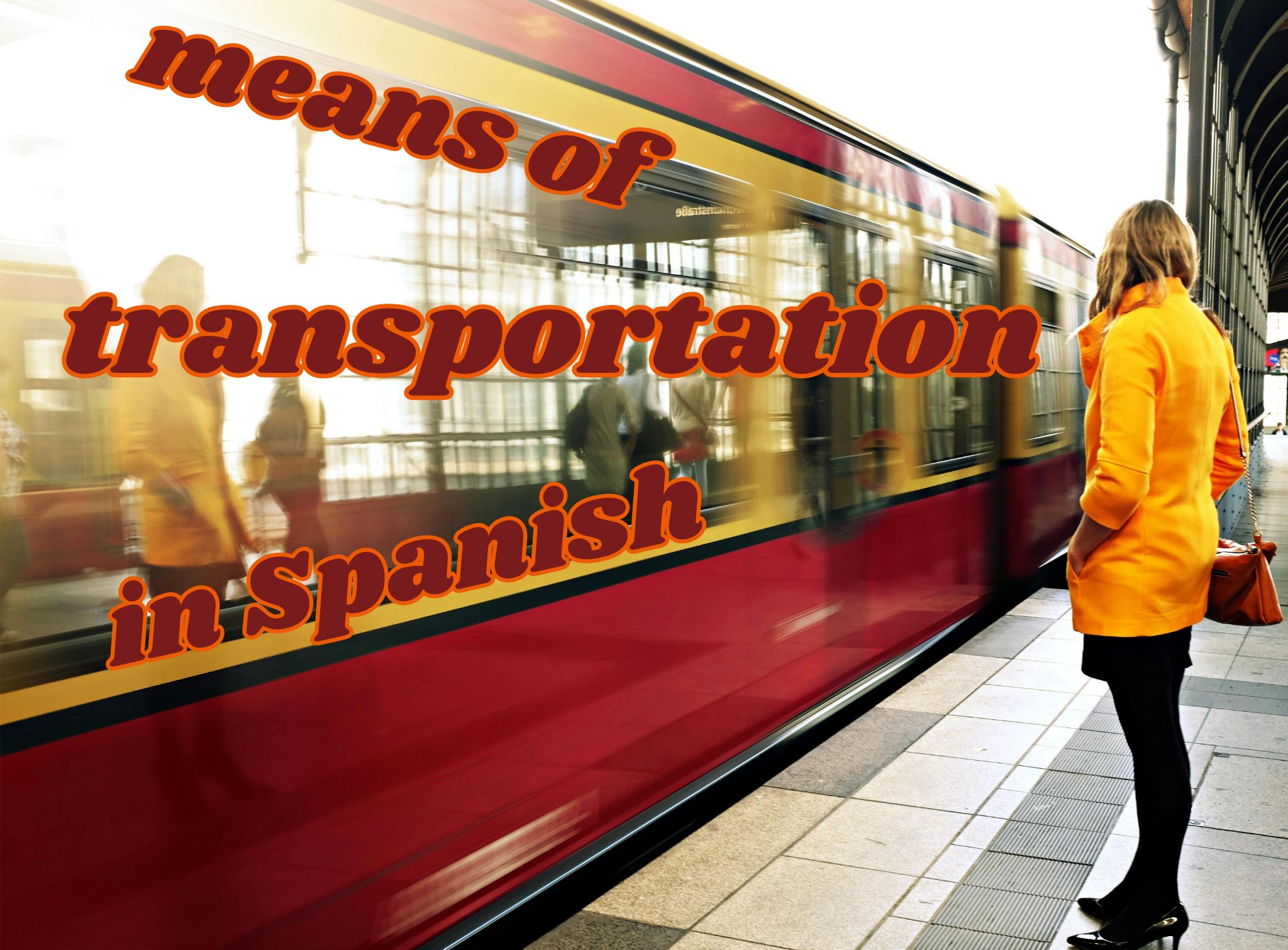Transportation in Spanish: Essential vocab to get around with ease

Get our free email course, Shortcut to Conversational.
Have conversations faster, understand people when they speak fast, and other tested tips to learn faster.
More infoWhen traveling through Spanish-speaking countries, you’ll need to know how to navigate the local transport systems. Public transport plays a fundamental role in daily life, particularly buses and trains. Knowing how to talk about transportation in Spanish is therefore vital if you want to have a smooth experience during your travels.
In this post, we’ll explore essential Spanish transportation vocabulary. We’ll provide detailed lists covering the most common means of transportation in Spanish, including real-life examples to show how to use these words in everyday situations.
We’ll also introduce useful phrases to help travelers catch the bus, take a train, buy tickets, and ask for directions. Knowing this basic vocabulary for transportation in Spanish while navigating city streets or planning longer journeys will make your experience much more manageable!
With this guide, you should be ready to travel by bus or train in Spanish-speaking countries. So go ahead and buy your tickets, take a seat, and get ready for your trip as you enjoy this adventure about transportation in Spanish!
Transportation in Spanish
The word for transportation in Spanish is transporte, a masculine noun. El transporte can refer to any type of transportation.
General transportation vocabulary
Let’s begin with some general words related to transportation in Spanish.
| English | Spanish |
| Ticket | El boleto |
| Driver | El chofer |
| Schedule | El horario |
| Transport card | La tarjeta de transporte |
| Seat | El asiento |
| Fare | La tarifa |
| Passenger | El pasajero |
| One-way ticket | El boleto de ida |
| Round trip ticket | El boleto de ida y vuelta |
| Arrival | La llegada |
| Departure | La salida |
| Route | La ruta |
| Destination | El destino |
| Platform | El andén |
| Map | El mapa |
| Traffic | El tráfico |
| Bus station | La estación de autobuses |
| Bus stop | La parada de autobús |
| Train Station | La estación del tren |
| Port | El puerto |
- The passenger bought the one-way ticket at the bus station. – El pasajero compró el boleto de ida en la estación de autobuses.
- My mom’s arrival time depends on the departure and the route that the driver took. – El horario de llegada de mi mamá depende de la salida y la ruta que tomó el chofer.
- We are waiting for my grandparents on platform six at the train station. – Estamos esperando a mis abuelos en el andén seis de la estación del tren.
Modes of transportation in Spanish – Medios de transporte
There are many ways to get around in any city or town. Knowing how to use these modes of transportation in Spanish is vital for daily life or travel.
From buses and trains to bicycles and taxis, let’s start with this user-friendly guide to the most common modes of transportation in Spanish. Dealing with these terms is an excellent way to navigate transportation like a local, making trips smoother and more accessible.
| Modes of transportation | Medios de transporte |
| Train | El tren |
| Bus | El autobús |
| Subway | El metro |
| Tram | El tranvía |
| Cable car | El teleférico |
| Taxi | El taxi |
| Limousine | La limusina |
| Car | El carro, El coche |
| Truck | El camión |
| Motorcycle | La motocicleta |
| Scooter | La scooter |
| Bicycle | La bicicleta |
| Unicycle | El monociclo |
| Skateboard | La patineta |
| Rollerblades | Los patines en línea |
| Horse-drawn carriage | El carruaje |
| Ferry | El ferri |
| Boat | El bote |
| Yacht | El yate |
| Sailboat | El velero |
| Airplane | El avión |
| Jet | El jet |
| Light aircraft | La avioneta |
| Helicopter | El helicóptero |
- After taking the bus to the station, we caught the train to the city, and once there, we rented bicycles to explore the park. – Después de tomar el autobús hasta la estación de autobuses, tomamos el tren hasta la ciudad y, una vez allí, alquilamos bicicletas para explorar el parque.
- We arrived by airplane and then took a taxi to the hotel, but tomorrow we’ll use the subway to visit the museum. – Llegamos en avión y luego nos fuimos en taxi al hotel, pero mañana utilizaremos el metro para visitar el museo.
- They took a ferry to the island, used a scooter to get around, and finally caught the tram back to the port. – Tomaron un ferry a la isla, utilizaron una scooter para moverse, y finalmente tomaron el tranvía de vuelta al puerto.
Now that we’ve learned the modes of transportation in Spanish, let’s explore useful phrases to catch a bus or a train.
Catching a bus – Tomar el autobús
Tomar el autobús in a Spanish-speaking country, or catching the bus, is an excellent way to move around a city or town. Los autobúses are a common and frequently safe mode of transportation for getting around. From finding the right estación de autobuses, to buying a ticket and asking for directions, being equipped with the correct vocabulary can save the day!
In our post of basic Spanish sentences you can memorize on the plane, we discussed useful phrases to use while in the airport. In this section, we’ll cover the essential phrases and words needed for a good experience without accidentally ending up in the wrong part of town!
| Phrases for catching the bus | Frases para tomar el autobús |
| Is this seat free? | ¿Está libre este asiento? |
| Is this seat taken? | ¿Este asiento está ocupado? |
| How much is the fare? | ¿Cuánto cuesta el pasaje? |
| Where can I recharge my transport card? | ¿Dónde puedo recargar mi tarjeta de transporte? |
| I lost my ticket / transportation card, where can I buy another one? | Perdí mi boleto / tarjeta de transporte, ¿dónde puedo comprar otra? |
| Where is the bus stop? | ¿Dónde está la parada de autobuses? |
| What time does the next bus come? | ¿A qué hora pasa el próximo autobús? |
| Is this bus direct or does it make stops? | ¿Este autobús va directo o hace paradas? |
| Do I need to transfer? | ¿Tengo que hacer transbordo? |
| Does this bus go to…? | ¿Este autobús va a…? |
| Excuse me, does this bus stop at the station? | Disculpe, ¿este autobús se para en la estación? |
| Is there a connection to get to…? | ¿Hay alguna transferencia para llegar a…? |
| Where should I get off to go to…? | ¿Dónde me bajo para ir a…? |
| What is the station to get off at…? | ¿Cuál es la estación para bajar en…? |
| When is the next stop? | ¿Cuándo es la próxima parada? |
| Which stop is this? | ¿Qué parada es esta? |
| Can you let me know when we get to the next stop? | ¿Me puede avisar cuando lleguemos a la próxima parada? |
| At the stop, please. | Por la parada, por favor. |
- Excuse me sir, how much is the fare and what time is the next bus? – Disculpe, señor. ¿Cuánto cuesta el pasaje y a qué hora pasa el próximo autobús?
- I asked the driver if the bus went direct or made stops and which was the station to get off near the museum. – Le pregunté al chofer si el autobús iba directo o hacía paradas y cuál era la estación para bajar cerca del museo.
- Ma’am, does this bus go to the central park or does it go directly to the bus station? – Señora, ¿este autobús va para el parque central o va directo a la estación de autobuses?
Normally, since you’re interacting with people you don’t know, it is essential to address them politely. Check out our related post with essential expressions of courtesy.
Taking the train – Tomar el tren
Tomar el tren, or taking the train in Spanish, is often one of the most scenic and relaxing ways to travel. Knowing how to navigate the system with the right Spanish train vocab will certainly make your life easier.
Let’s take a look at some basic train vocabulary in Spanish, like buying tickets, finding the right platform, or asking about travel times. Here we present useful phrases to ensure that your train travels in Spanish go smoothly, from boarding to getting off at the right stop.
Of course many of the phrases we just saw for taking the bus in Spanish can just as easily be applied to trains too, and vice versa. So hop on board and enjoy the ride!
| Phrases for taking the train | Frases para tomar el tren |
| Where can I find the train schedule? | ¿Dónde puedo encontrar el horario de los trenes? |
| What time does the next train leave? | ¿A qué hora sale el próximo tren? |
| How long does the train take to arrive? | ¿Cuánto tiempo tarda el tren en llegar? |
| When does the last train of the day leave? | ¿A qué hora sale el último tren del día? |
| What time do we arrive at the final station? | ¿A qué hora llegamos a la estación final? |
| What is the last stop for this train? | ¿Cuál es la última parada de este tren? |
| Is this train going north or south? | ¿El tren va al norte o al sur? |
| Excuse me, where is platform number…? | Disculpe, ¿dónde está el andén número…? |
| A train ticket, please. | Un boleto de tren, por favor. |
| Can I reserve a seat on this train? | ¿Puedo reservar un asiento en este tren? |
| Can I change my ticket for another train? | ¿Puedo cambiar mi boleto para otro tren? |
| Is this a high-speed train? | ¿Es un tren de alta velocidad? |
| Does this train have Wi-Fi? | ¿El tren tiene Wi-Fi? |
| Is there a dining car on this train? | ¿Hay un vagón restaurante en este tren? |
| Are there sleeping cars on this train? | ¿Hay vagones para dormir en este tren? |
| How much luggage can I bring on this train? | ¿Cuánto equipaje puedo llevar en el tren? |
| I need help with my luggage, please. | Necesito ayuda con mi equipaje, por favor. |
| I’m getting off at the next station. | Me bajo en la siguiente estación. |
- Where can I find the train schedule? I’m interested in the last train of the day. Also, is this train direct, or do I need to transfer? – ¿Dónde puedo encontrar el horario de los trenes? Me interesa el último tren del día. Además, ¿este tren es directo o tengo que hacer transbordo?
- Excuse me, what is the last stop for this train? Can you let me know how much longer until we arrive? – Perdón, ¿cuál es la última parada de este tren? ¿Puede avisarme cuánto falta para llegar?
- I need to change my ticket for another train. How much luggage can I bring? And, is there a dining car on this train? – Necesito cambiar mi billete para otro tren. ¿Cuánto equipaje puedo llevar? Y, ¿hay un vagón restaurante en este tren?
Although this blog is about transportation in Spanish, to best prepare for your trip, you can review this post, 105 Spanish travel phrases to know for your next trip.
Transportation in Spanish Verbs: Verbos
Ok now that we’ve seen all the useful phrases for catching buses and trains in Spanish, let’s cover a bunch of the most common verbs for talking about transportation in Spanish.
| English travel verbs | Spanish travel verbs |
| To travel | Viajar |
| To move | Moverse |
| To go | Ir |
| To stop | Parar |
| To walk | Caminar |
| To go by, To ride [a bus, a train, a plane] | Ir en, Viajar en |
| To ride [a horse, a bicycle] | Montar |
| To drive | Manejar, Conducir |
| To park | Estacionar |
| To ask for directions | Pedir direcciones |
| To buy | Comprar |
| To pay | Pagar |
| To reserve | Reservar |
| To wait | Esperar |
| To catch | Agarrar |
| To miss | Perder |
| To depart | Salir, Partir |
| To arrive | Llegar |
| To get on | Subir |
| To get off | Bajarse |
| To check | Revisar, Chequear |
Conclusion: Transportation in Spanish
Well done! Now you’re ready to get around a city in a Spanish-speaking country with a full set of vocabulary for transportation in Spanish. Let’s do a quick recap before the bus comes!
First, we learned how to say transportation in Spanish and covered some general Spanish transportation vocab. Our bus tour continued by learning the most common modes of transportation in Spanish. The next stops were to cover essential phrases for catching a bus and a train, with some examples to illustrate how they work in daily conversations. Finally, we looked at some common Spanish transportation verbs.
Knowing how to talk about transportation in Spanish, from the different means of transportation to common phrases, like ¿A qué hora sale el tren? or ¿Este asiento está disponible?, will surely come in handy in everyday situations. From finding a bus stop to taking the subway, mastering these expressions will make your journey much smoother.
Have a good trip!


